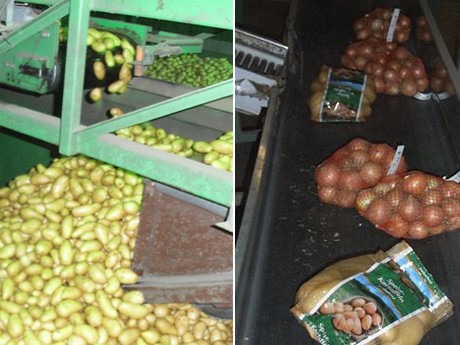The Lower Saxon potato traders are currently very far into the marketing of their products, After prices in the Rhineland at the start of January increased by €5.00 Euro per 100 kg, in the northern growing areas the willingness to deliver goods came to a standstill. Therefore it was necessary to adjust the prices there in order to continue to get the supply to the trade to get going again. The current stocks in the northern storage rooms would normally be sufficient until the end of March-beginning of April, says a spokesman for the Raiffeisen Warengenossenschaft Ost-Hannover e.G.

Rising prices and willingness to pay
Farmers from Lower Saxony hesitated somewhat with their shipments in the beginning of January. To push the willingness of Lower Saxony growers to start sending out goods again, traders had to dig deeper into their pockets. "As a result, we were able to raise prices by about €5 euros per 100 kg about 10 days ago. Before that, we had quite stable prices from October to mid-January at €27 per 100 kg (mainly hard boiling) and at €29 per 100 kg (hard boiling) At the moment we are at producer prices of between €31-34 per 100 kg."
Physiological properties
Since in Eastern Germany -primarily Saxony and Brandenburg- there is currently a below-average inventory, tubers from Lower Saxony are currently in high demand in the local trade. On the other hand, speedy marketing is also necessary to some extent. Because it must also be clear that, due to the high physiological age of the potatoes, it is advisable to market the tubers quickly. "We currently believe that the stored batches should be marketed by the end of March because they probably will not last much longer in terms of quality, and some varieties are even more vulnerable during storage."
Connection to the new harvest
Overall, it is currently believed that predominantly hard boiling varieties, will be the more popular tubers. They are still on offer there, but from early-mid-March onwards, some shortages may occur in certain varieties. Therefore, it is likely that imports will supplement the market sooner than usual. However, this also depends on when the harvests will start in the important export countries Egypt and Israel. They usually send their first shipments to western Europe at the beginning of April. "In addition to all this, we will probably also get some shipments in from France, before the first new potatoes from German soil will be back on the market."

Supra-regional marketing
Raiffeisen Goods Cooperative (RWG) e.G. supervises the production and direct supply of the potato branch of Lower Saxony. The company mainly supplies its own packaging and wholesale company Groka GmbH, as well as supra-regional wholesale customers. A large part of the regional crops ends up on the shelves of major supermarket chains.
For more information:
Raiffeisen-Warengenossenschaft e.G.
Osthannover eG
Raiffeisenstr. 8, 31311 Uetze
Tel.: +49 51 73 / 69 2-0
Fax: +49 51 73 / 6 92 220
eMail: info@rwg-osthannover.de
Internet: www.rwg-osthannover.de/
Groka Dollbergen GmbH
Eddesser Landstr. 6
31311 Uetze-Dollbergen 
Tel.: 05177/86-0
info@groka-dollbergen.de
www.groka-dollbergen.de
